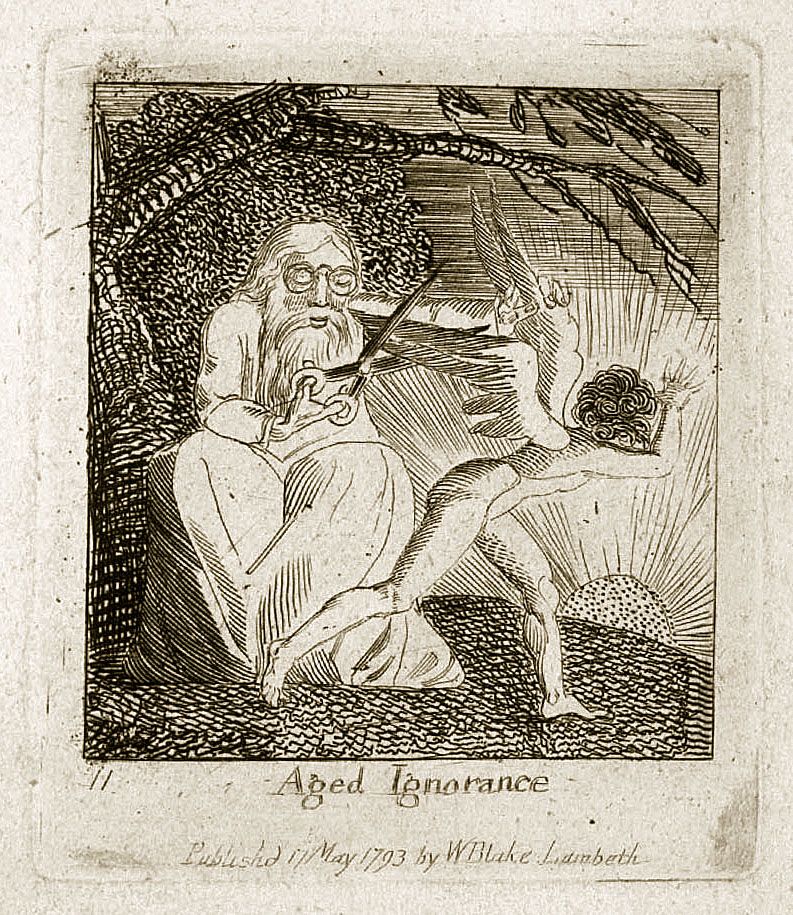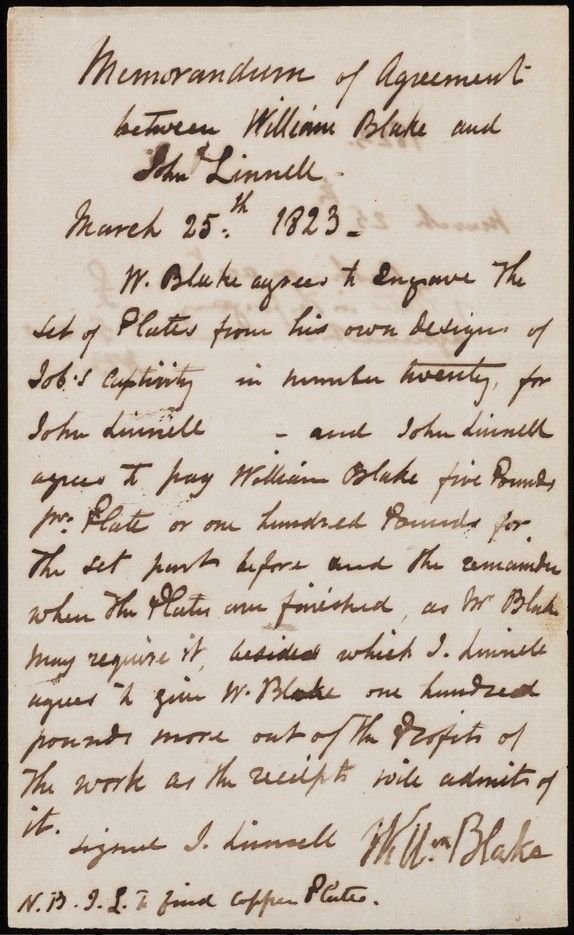[To] Mr [George] Cumberland, Bishopsgate,
Windsor Great Park
[From] Hercules Buildings, Lambeth. Augst 26. 1799
...
As to Myself about whom you are so kindly Interested. I
live by Miracle. I am Painting small Pictures from the Bible.
For as to Engraving in which art I cannot reproach myself with
any neglect yet I am laid by in a corner as if I did not Exist &
Since my Youngs Night Thoughts have been publishd Even Johnson &
Fuseli have discarded my Graver. But as I know that He who Works
& has his health cannot starve. I laugh at Fortune & Go on &
on. I think I foresee better Things than I have ever seen. My
Work pleases my employer & I have an order for Fifty small
Pictures at One Guinea each which is Something better than mere
copying after another artist. But above all I feel myself happy
& contented let what will come having passed now near twenty
years in ups & downs I am used to them & perhaps a little
practise in them may turn out to benefit. It is now Exactly
Twenty years since I was upon the ocean of business & Tho I laugh
at Fortune I am perswaded that She Alone is the Governor of
Worldly Riches. & when it is Fit She will call on me till then I
wait with Patience in hopes that She is busied among my Friends.
With Mine & My Wifes best compliments to Mr Cumberland
I remain
Yours sincerely
WILLm BLAKE
Included in this post is information from
William Blake: His Art and Times by David Bindman and from other sources.
The commission which Blake reported in his letter to his friend
George Cumberland, according to Bindman, was his first from Thomas Butts.
In the next year, 1799-1800, Blake painted fifty small (aproximately
10x15 inches) tempera pictures illustrating the bible for Butts. The
medium which Blake used to paint the temperas did not prove to be as
satisfactory as would have been desired. As a binder Blake used glue and gums,
sometimes in layers, which created problems as the pictures aged.
Although about
thirty of the pictures are available in public and
private collections, their appearance is far from the original intent.
Cracking and darkening is the result of failure of the original
technique and also subsequent attempts at restoration.
 |
Rhode Island School of Design Museum of Art
The Baptism of Christ
1799-1800 Tempera |
In this example from the tempera set of biblical illustrations we see
that the gem-like colors which Blake intended to produce have been lost,
along with much of the clear definition which he so valued.
Butts continued to purchase biblical illustrations from Blake but
after the first fifty, the paintings were watercolors to which time has
been much kinder. Below from the year 1803 is Blake's watercolor of the
same subject.
 |
Ashmolean
The Baptism of Christ
c. 1803
Pen and Black Ink and Watercolour |
Matthew 3
[11] I indeed baptize you with water unto repentance: but he that
cometh after me is mightier than I, whose shoes I am not worthy to
bear: he shall baptize you with the Holy Ghost, and with fire:
[12]
Whose fan is in his hand, and he will throughly purge his floor, and
gather his wheat into the garner; but he will burn up the chaff with
unquenchable fire.
[13] Then cometh Jesus from Galilee to Jordan unto John, to be baptized of him.
[14] But John forbad him, saying, I have need to be baptized of thee, and comest thou to me?
[15]
And Jesus answering said unto him, Suffer it to be so now: for thus it
becometh us to fulfil all righteousness. Then he suffered him.
[16]
And Jesus, when he was baptized, went up straightway out of the water:
and, lo, the heavens were opened unto him, and he saw the Spirit of God
descending like a dove, and lighting upon him:
[17] And lo a voice from heaven, saying, This is my beloved Son, in whom I am well pleased.
Mark 1
[1] The beginning of the gospel of Jesus Christ, the Son of God;
[2] As it is written in the prophets, Behold, I send my messenger before thy face, which shall prepare thy way before thee.
[3] The voice of one crying in the wilderness, Prepare ye the way of the Lord, make his paths straight.
[4] John did baptize in the wilderness, and preach the baptism of repentance for the remission of sins.
[5]
And there went out unto him all the land of Judaea, and they of
Jerusalem, and were all baptized of him in the river of Jordan,
confessing their sins.
[6] And John was clothed with camel's hair, and with a girdle of a skin about his loins; and he did eat locusts and wild honey;
[7]
And preached, saying, There cometh one mightier than I after me, the
latchet of whose shoes I am not worthy to stoop down and unloose.
[8] I indeed have baptized you with water: but he shall baptize you with the Holy Ghost.
[9] And it came to pass in those days, that Jesus came from Nazareth of Galilee, and was baptized of John in Jordan.
[10] And straightway coming up out of the water, he saw the heavens opened, and the Spirit like a dove descending upon him:
[11] And there came a voice from heaven, saying, Thou art my beloved Son, in whom I am well pleased.
[12] And immediately the Spirit driveth him into the wilderness.
Luke 3
[21] Now when all the people were baptized, it came to pass, that Jesus also being baptized, and praying, the heaven was opened,
[22]
And the Holy Ghost descended in a bodily shape like a dove upon him,
and a voice came from heaven, which said, Thou art my beloved Son; in
thee I am well pleased.
John 1
[25] And they asked him, and said unto him, Why baptizest thou then, if thou be not that Christ, nor Elias, neither that prophet?
[26] John answered them, saying, I baptize with water: but there standeth one among you, whom ye know not;
[27] He it is, who coming after me is preferred before me, whose shoe's latchet I am not worthy to unloose.
[28] These things were done in Bethabara beyond Jordan, where John was baptizing.
[29] The next day John seeth Jesus coming unto him, and saith, Behold the Lamb of God, which taketh away the sin of the world.
[30] This is he of whom I said, After me cometh a man which is preferred before me: for he was before me.
[31] And I knew him not: but that he should be made manifest to Israel, therefore am I come baptizing with water.
[32] And John bare record, saying, I saw the Spirit descending from heaven like a dove, and it abode upon him.
[33]
And I knew him not: but he that sent me to baptize with water, the same
said unto me, Upon whom thou shalt see the Spirit descending, and
remaining on him, the same is he which baptizeth with the Holy Ghost.
[34] And I saw, and bare record that this is the Son of God.








